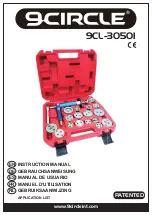
Ultra Tugger
®
Cable Puller and Pulling Packages
Greenlee / A Textron Company
4455 Boeing Dr. • Rockford, IL 61109-2988 USA • 815-397-7070
21
Cable Pulling Principles
(cont’d)
Summary of Cable Pulling Principles
A cable pulling system consists of many components
that work together to accomplish a pull.
The cable puller is rated by its maximum pulling
force; every other component is rated by its maximum
rated capacity. The maximum rated capacity of every
component must meet or exceed the maximum
pulling force of the cable puller.
The cable puller must overcome two types of resis-
tance: gravity and friction. The puller’s capstan, the
pulling rope, and the operator tailing the rope work
together to produce pulling force.
The cable puller exerts force on every component
of the cable pulling system, including the anchoring
systems and the support structures.
Energy is stored in a rope when the load causes
the rope to stretch. Failure of the rope or any other
component can cause a sudden release of energy.
Replace any rope that is worn or damaged.
Carefully select the number or wraps of rope around
the capstan before starting the pull.
Control the pull by tailing the rope. Be familiar with the
interaction of the rope and capstan.
Do not allow a rope overlap to develop.
•
•
•
•
•
•
•
•
Pull in a direction that will require the lowest amount
of pulling force.
Plan several shorter pulls rather than fewer longer
pulls.
Locate the puller as close to the end of the conduit
as possible to minimize the amount of exposed rope
under tension.
Place each component so that the pulling forces are
used effectively.
Select an anchoring system: adapter sheaves, which
are preferred, or the floor mount.
Verify that each component has the proper load
rating.
Inspect the structural supports. Verify that they have
enough strength to withstand the maximum forces
that may be generated.
•
•
•
•
•
•
•
Planning the Pull
















































